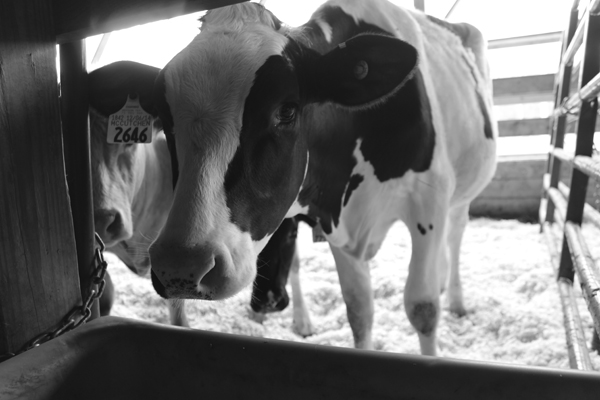An Office With a View
Dairy farming is not a money-making endeavor. People stick with it because of the lifestyle it offers, because they have a family history, would much rather work out in a field or with a barnful of obstinate cows than being tied down to a desk. Although there’s a fair amount of desk time with the payroll, animal records, and breeding schedules, you still have a chance to escape when need be.
Sarrah Simpson is at the heifer farm, a smaller, second farm part of the larger Simpson View Farm, where they keep weaned calves up until they are ready to have their first calf and dry cows. While Simpson View has barns on both sides of the main drag in Corinna, you have to navigate dirt roads through the woods to get to the heifer farm.
“I love coming out here from the other farm,” Sarrah said. “It’s so different. There’s no traffic and it’s quiet.”



At 21 years old, Sarrah has taken over much of the bookwork at her family’s 740 cow (milking, they have twice that with young stock and dry cows) dairy farm. She and her sister Sam, 19, are also in charge of calf care. Their 17-year-old brother R.J. can often be found on a tractor at the farm or a tractor pull at the fair. He looks to become a mechanic after high school, a useful trade on a dairy farm.
Sarrah studied business marketing and management at the local college but never toyed with the idea of leaving the farm or doing anything other than dairy farming. Instead, she puts those business skills to work at home.
“I always knew I would just be here,” she said. “It’s your family, and you’re doing something that is for you, your business, your family.”
Sarrah is also the public relations rep for her family’s farm. She leads tours for preschool children to college groups. While the tours do not bring any money for the farm, Sarrah feels they are an important way to reach the public.
“The public doesn’t realize how important farming is to what they have,” she said. “Without farming, we wouldn’t have anything.”
Simpson View Farm has 15 employees counting Sarrah, Sam, their brother R.J., and their parents Ronald and Julie. They milk three times a day and ship 60,000 pounds of milk each day to Oakhurst. Their cows average more than 80 pounds of milk per day (that’s about 10 gallons per cow).
Ronald’s father, Roger, started the farm. Before the farm was big enough to support the Simpson family alone, Roger also delivered mail. Ronald took over Simpson View Farm in the early 1980s when they were milking 39 cows in a double 4 parlor (eight cows at a time).
The herd has grown steadily since then, as has the milking parlor. “Dad would upgrade the parlor, doubling it every time, and every time he added more cows.” Today their parlor is a double 16, meaning 32 cows can be milked at once.

The additional cows require additional barns. It seems like new construction is happening all the time at Simpson View. Cows are separated into low and high milkers.
First-calf heifers have their own barn, so they are not pushed around by older, bigger cows. A barn originally built for dry cows is now the calving barn because many are due to calve. A new “pre-fresh” (due to have a calf soon) barn is in the works.



Sarrah and Sam are responsible for nearly 80 calves at one time, caring for them until they are 10 weeks old and ready to be moved to the other farm. Although that’s a large number, Sarrah said she still gets attached to the calves, especially the runts who require extra care. She likes to pick them out in the milking barn, all grown up.
That attachment and knowing all the time and work that went into each calf, even before it was born, can make the loss of even a single calf difficult. A little over a year ago, though, the Simpsons lost their entire calf barn of 80 calves to a fire. The family was in Presque Isle, about three hours away, to watch R.J. compete in a tractor pull there when they got the call.
“It was the eeriest feeling because there was absolutely nothing we could,” Sarrah said of the long ride home. “It was hard, but you have to keep going. You can’t stop and fret about it.”
A new calf barn was built. The family pushed forward with a new crop of calves.

While the Simpsons’ home lives are consumed by dairy farming, their time away from the farm is also centered around farming. Sam and R.J. show their Holsteins at the fair. Up until a couple of years ago, Sarrah did as well. R.J. is competitive in tractor and truck pulls at the fair. Sarrah is also a co-director with the Maine Dairy Scholarship Pageant, which requires year-round planning and involvement.















